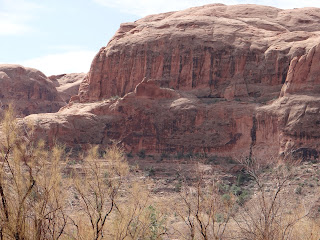The Bureau of Land Management (hereafter: BLM) has an amazing policy regarding public access to precious rock art sites and pueblo ruins (found in many of the canyons in SE Utah). Rather than restricting public access, the BLM in the 1990s adopted the concept of creating an “outdoor museum.”
This means that hikers and tourists are free to “discover” and explore prehistoric sites on their own. It is the honor system. Nothing is to be removed (or touched in the case of rock art). If a hiker should actually make a discovery of an unrecorded find, he/she is to report it to a BLM officer. This has actually happened in a number of recent cases documented by the Edge of Cedars State Museum in Blanding, UT.
It is a risky policy. Compare the situation of the Courthouse Wash near Moab. But it allows Americans and Europeans (those Germans and French again) to experience the power of America’s ancient heritage in a way that our eastern policies of regulation and museum competitiveness cannot do. David Roberts’ book, In Search of the Ancient Ones, has some interesting stories to tell about the development of this policy.
Today we revisited the “Potash Road” sites, taking even more extensive field notes. The Potash Road, by the way, leads to “Dead Horse Point,” of movie fame and to the northern portion of Canyonlands National Park.
They are also directly across from the natural amphitheater where we found the “Moab Maiden” at the confluence of Kane Creek Canyon and the Colorado River. We did not realize that until we had climbed up to the “maiden” petroglyph. No one else has noticed the coincidence, so far as I have discovered.
I wonder if this is actually a coincidence after all. The main panels on the Potash Road site are near a spot where true rock climbers today rappel up the sheer cliffs,
just as ancient Anasazi climbed up the same cliffs—like the lizards in my earlier photos. (It is a famous spot for adventurers.)
But more importantly, these rock art panels feature rows of anthropomorphic figures holding hands.
They appear to be dancing.
Could this be a ritual procession to the site of the “maiden”?
The setting is perfect for sacred outdoor performances. The river and canyon paths converge here. And the amazing canyons, buttes, and spires of canyonlands are on the horizon. Was this a “sacred” spot, where various clans gathered for special purposes? Did they dance there holding hands to the tunes of a “Kokopelli” flute player? Were there war ceremonies
and hallucinogenic visions?
In the afternoon, with energy to spare, we decided to drive 50 miles south of Moab to Indian Creek canyon, where two different petroglyphic locations awaited us.
The first was the famous “Newspaper Rock.” Complex and theatrical. The location of the panel was like the marquis of a movie theater.
Its imagery spans the Anasazi,
Fremont,
and historical Ute peoples.
It was a kiosk along Indian Creek that was used and reused by various cultures for over a thousand years.
Its imagery is too complex to describe right now.
A few miles further down the canyon, at the confluence with Shay Creek Canyon, we explored another extensive rock art site, dating back to the Anasazi era (600-1200 A.D.).
We expected to see a few roadside petroglyphs. Instead, we found ourselves climbing 150 feet and examining petroglyphs spread over 600 yards along the cliff face.
The floors of the two canyons at this point were rich in pinyon and juniper trees and obviously good hunting and gathering grounds 2,000 years ago. (Not today after overgrazing by cattlemen, I mean by cattle, in the twentieth century.)
The Shay Canyon petroglyphs had a fantastic number of curious features. However, none were as fun to study as the several “Kokopelli” flute players.
You need to know that Kokopelli was a trickster and fertility figure in Anasazi mythology (and still is among Pueblo peoples). His flute (get it?) attracts the maidens, like a Pied Piper, but it also calls forth the animals and the vegetation from the mountains and the soil.
Even more interesting were the anthropomorphic figures facing the Kokopelli images.
They appear to be dancing; some with their legs bent as if touching.
They were holding hands, as if in ritual reverie.
Even the Mountain Sheep surrounding them on the panels seemed to be leaping in the air, as if dancing.
Were they returning from the Potash Road ceremonies? Just kidding.























I think the figures are being pulled and "floating" toward Kokopelli as if they have no will of their own.
ReplyDeleteYour pictures are amazing and I am worn out thinking about your hikes. Janet, you are not just sitting around in retirement are you?? I sure would like to see these things in person but, having you there is the next best thing! Keep on with the blog--it's fantastic.